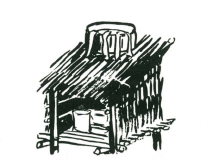
A camp larder is simply a platform, roofed over with thatch and with the sides thatched so that it is dark and cool inside. Darkness will help to keep flies away, and coolness will help to prevent food going bad. An excellent improvement to a camp larder is a water tin suspended above the thatch, with a few pieces of cotton rag to siphon water on to a thatched roof. This is almost a camp refrigerator. The temperature inside such a larder, if built in a shady position and with a good breeze, will be easily twenty to forty degrees below the shade temperature outside.
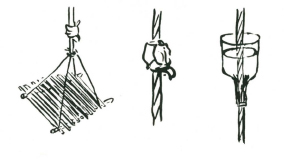
Other methods of storing food in camp away from animals include placing it in a hollow log wedged in the crotch of a tree, or suspending it from a bough, or making a platform and suspending this from a branch in a shady position. If ants are a pest, suspending the platform is probably one of the best ways to keep them away from your food. If they do find the cord, you can prevent them from travelling along to your food by tying a kerosene-soaked rag around the cord. Another method is to break a bottle off above the neck, pass the cord through the cork, and then, after packing clay around the rope where it passes the neck, fill with water. Water will soak down the rope and the bottle will need frequent filling.

Usually in camp, one’s travelling clothes become crushed and soiled. This can easily be prevented by making a simple coat and trousers hanger. If you take off your good clothes immediately you arrive in camp and put them on this coat-hanger, they will remain fresh and uncreased.

This “Adirondack” pack is a good method of carrying gear in camp. The cross sticks are tightly lashed to the two hooked sticks. Shoulder straps are plaited from reeds or made from wide strips of soft bark.
CAMP SUN CLOCK
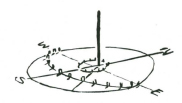
Select a patch of bare earth near your camp. It must be level, and open to the sun all day. Stick a peg in the centre of this patch, and with a length of cord as a loop around the peg, scratch a circle on the ground. This must be at least five feet across. From the peg, which is now the centre of the circle, carefully draw a line TRUE north. This must be accurately TRUE, and not Magnetic. Extend this line to cut the southern side of the circle, and then draw in accurate East-West lines crossing at the circle’s centre.
Divide the circumference of the circle into twenty-four equal divisions. Each of these divisions will be fifteen degrees.
Now have a look at your map and find out what degree of latitude you are in. Measure this in degrees on the out side circle, working from where it is cutting the East-West line. Put a small peg on each side of the circle’s edge to mark the latitude degrees.
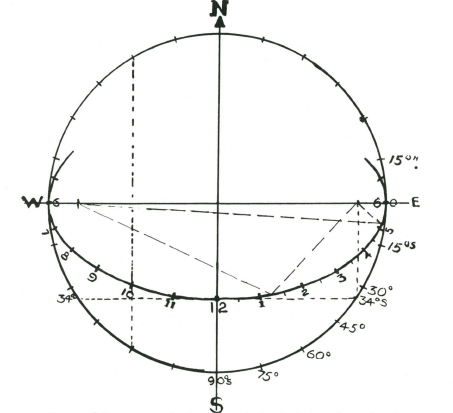
Be careful to note whether your latitude is North or South of the Equator. Stretch the cord over the two pegs and mark where it crosses the North-South line. Now put a peg on the North-South line where the cord crosses it. Next, put two other pegs at either end of the East-West line so that the “degree” pegs on the circle are at right angles. Tie a cord to each of these pegs, and have the cord pass round the peg on the North-South line. Lift the cord over the centre peg, and with the point of your knife, scratch an elipse on the ground, so that it touches the circle where the East-West line crosses, and also touches the point on the North-South line where the peg is.
Connect up the fifteen degree marks on the circle by means of the cord and parallel with the North-South line. Where the cord crosses the ellipse, put a small peg very firmly into the ground.
There will be thirteen of these pegs, and they will follow the curve of the ellipse. These are the hour pegs, starting from 6 a.m. on the left, where the West line cuts the circle, 12 noon on the North-South line, and 6 p.m. on the right where the East line cuts the circle.
You must now know how to find where to place the shadow stick. This depends on the sun’s position North or South of the Equator.

TO FIND THE SUN’S POSITION NORTH OR SOUTH OF THE EQUATOR
Draw another circle inside the big circle using the same centre. The radius of this circle must be equal to 23½ degrees of the big circle. Divide this circle into twelve equal divisions and mark June at the North side; July, etc., follow clockwise. Divide June into four equal divisions, and do the same with December (at the South end). Offset ALL divisions one-fourth in a clockwise direction. The North-South line will now pass through the third division of June and December. Put pegs in for each of the twelve months’ divisions.
To find the sun’s position at any time of the year, draw a line from the month, and approximate day thereof, to the North-South line. This must parallel the East-West line. Where this line cuts the North-South line is where you place your shadow stick.
To get absolutely reliable time from the sun, two corrections for longitude, and for the “equation of time” are required.
The “shadow” reading, with these corrections, will be right to two minutes, if your North-South line has been accurate.
If West of the Meridian of Standard Time, add four minutes to sun clock time for each degree. East, deduct four minutes for each degree.
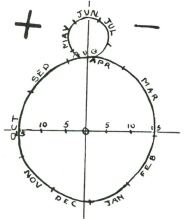
Draw a figure 8 near the sun clock on the ground, with the top half of the 8 just less than one-third the bottom half. Divide a line across the bottom half into three equal divisions on each side of a centre line.
Each of these divisions represents five minutes of time.
Now mark off the figure 8 into approximate divisions like the sketch. Put pegs in the ground to mark these divisions, and also the five minute divisions on the cross line.
Put a MINUS sign on the right-hand corner, and a plus on the right.
MINUS means that the sun time is behind clock time, and so you must ADD. Plus means that the sun time is ahead of clock time.
CHAPTER 4
FOOD AND WATER
Many people associate survival with the ability to find food and water. These of course are essential to sustain life.
In all areas, except the most arid, food and water in sufficient quantities are available, but the fear in many people’s minds is that the food they find may be poisonous, or the water polluted.
This book establishes safe principles for recognising foods which are edible and safe, and ways to overcome possible contamination of water, no matter how badly it may appear polluted.
The search for, and recognition of edible foods sharpens and develops three of man’s senses, sight, taste and smell. On the use of these depends the searcher’s success in finding food and water.
Associated with the finding of natural foodstuffs which are edible and safe, is the preparation of these.
Bearing in mind that the person concerned with survival may have no equipment except a knife or machete, the cooking of food and boiling of water may be no less important than the actual finding of these. It is for this reason that these subjects are included in this book.
Food and water are essential to living. Under normal conditions a person cannot live longer than three days without water, but one can live ten days or longer without food.